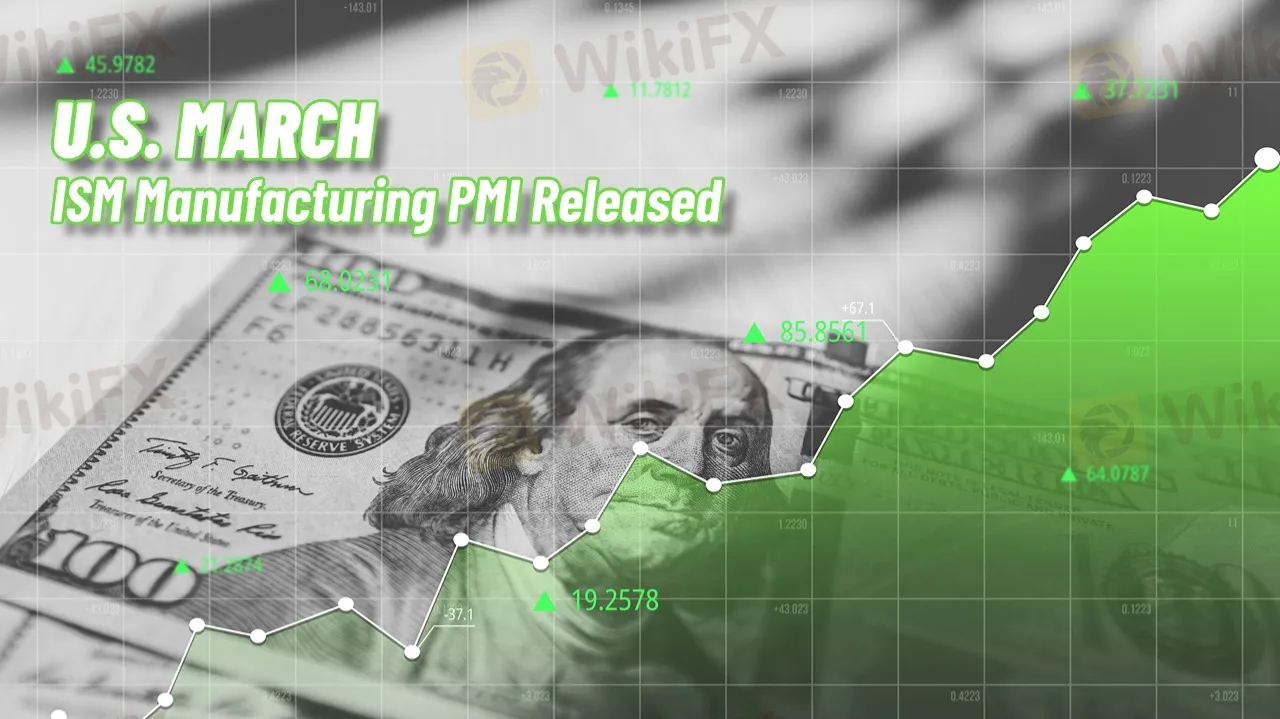简体中文
繁體中文
English
Pусский
日本語
ภาษาไทย
Tiếng Việt
Bahasa Indonesia
Español
हिन्दी
Filippiiniläinen
Français
Deutsch
Português
Türkçe
한국어
العربية
U.S. March ISM Manufacturing PMI Released
Abstract:The U.S. March ISM Manufacturing PMI data shows that manufacturing has contracted for the first time, and investors should pay attention to future changes and impacts on the sector.

According to the ISM manufacturing PMI data released on April 1, the U.S. manufacturing sector has contracted for the first time, with the price index surging, indicating the risk of an economic slowdown. Investors should closely monitor future developments and impacts on manufacturing.
The March ISM manufacturing PMI dropped to 49, lower than the expected 49.5 and down from 50.3 in February. A reading of 50 is considered the dividing line between expansion and contraction, meaning U.S. manufacturing is experiencing a downturn. At the same time, the price index rose sharply by 7 points to 69.4, reaching its highest level since June 2022. This increase highlights growing production cost pressures, especially from rising raw material prices.
The weakness in factory orders and employment indicators further emphasizes the impact of insufficient demand on the manufacturing sector, with the factory orders index falling to 45.2, the lowest level since May 2023.
These data suggest that the challenges facing U.S. manufacturing are intensifying, particularly due to the dual effects of tariff policies and weak demand. While certain industries are still showing growth, the overall signs of economic slowdown are becoming more pronounced, and the outlook for manufacturing is not optimistic.
For investors, the current market is filled with uncertainty, and it is essential to adjust investment strategies prudently. Focus on defensive sectors, such as utilities and consumer staples, which may offer more stable returns.
Meanwhile, the commodity market, especially metals and energy commodities, may be impacted by price fluctuations, and investors should assess risks and consider appropriate investment opportunities. Future economic data will be key to assessing the direction of the economy.

Disclaimer:
The views in this article only represent the author's personal views, and do not constitute investment advice on this platform. This platform does not guarantee the accuracy, completeness and timeliness of the information in the article, and will not be liable for any loss caused by the use of or reliance on the information in the article.
Read more

Never Heard of Dynasty Trade? Here's Why You Should Be Worried
Have you heard this name before? No , it’s time you do because staying unaware could cost you. This platform is currently active in the forex trading and has been linked to several suspicious activities. Even if you’ve never dealt with it directly, there’s a chance it could reach out to you through ads, calls, messages, or social media. That’s why it’s important to know the red flags in advance.

WEEKLY SCAM BROKERS LIST IS OUT! Check it now
If you missed this week's fraud brokers list and are finding it difficult to track them one by one — don’t worry! We’ve brought together all the scam brokers you need to avoid, all in one place. Check this list now to stay alert and protect yourself from fraudulent brokers.

Catch the Latest Update on BotBro & Lavish Chaudhary
BotBro, an AI-based trading platform, became popular in India in 2024—but for negative reasons. Its founder, Lavish Chaudhary, who gained a huge following by promoting it heavily on social media. Since then, he has become well-known, but for many controversies. Let’s know the latest update about Botbro & Lavish Chaudhary.

Trading Other People’s Money | What Prop Firms Don’t Tell You
Proprietary (prop) trading firms have become increasingly popular. They give traders the chance to trade with larger amounts of money without risking their own savings. For many, this sounds like the perfect opportunity to grow faster and earn more. But while the benefits are appealing, there are also risks and hidden rules that traders must understand before joining a prop firm.
WikiFX Broker
Latest News
Asia-Pacific stocks fall as investors weigh recent trade developments
Is Your Forex Strategy Failing? Here’s When to Change
FSMA Warns That Some Firms Operate as Pyramid Schemes
Apex Trader Funding is an Unregulated Firm | You Must Know the Risks
LVMH shares jump 2.5% after reporting better-than-feared earnings, Texas factory plans
Why Octa Is the Ideal Broker for MetaTrader 4 & 5 Users
Stop Level Forex: How Does it Help Traders Prevail When Losses Mount?
5 things to know before the Thursday open: Meme stock revival, Trump's Fed visit, Uber's gender feature
CNBC's Inside India newsletter: Leaving, but not letting go — India's wealthy move abroad, but stay invested
Moncler raises prices on tariffs, may postpone store openings if downturn worsens
Currency Calculator


